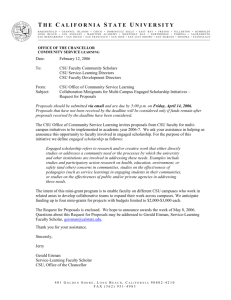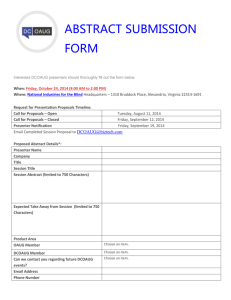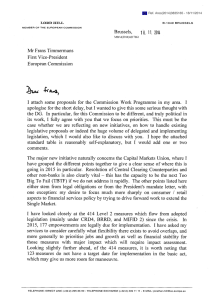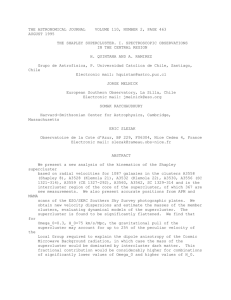NIH/NIAID Region V Great Lakes - Colorado State University Flint
advertisement
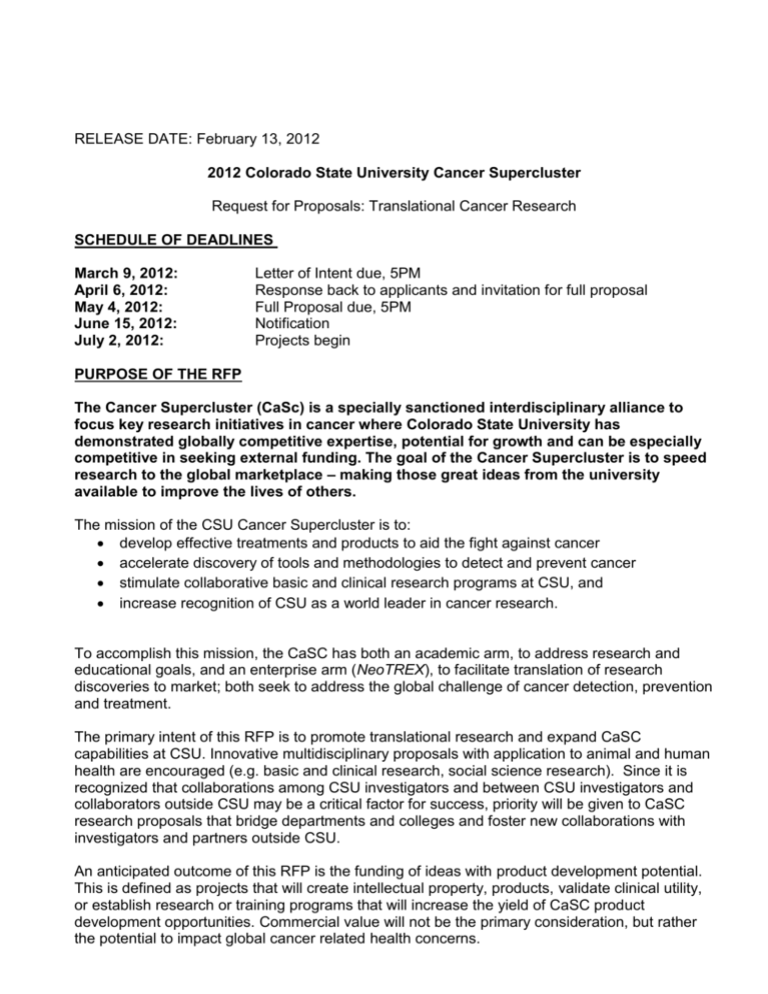
RELEASE DATE: February 13, 2012 2012 Colorado State University Cancer Supercluster Request for Proposals: Translational Cancer Research SCHEDULE OF DEADLINES March 9, 2012: April 6, 2012: May 4, 2012: June 15, 2012: July 2, 2012: Letter of Intent due, 5PM Response back to applicants and invitation for full proposal Full Proposal due, 5PM Notification Projects begin PURPOSE OF THE RFP The Cancer Supercluster (CaSc) is a specially sanctioned interdisciplinary alliance to focus key research initiatives in cancer where Colorado State University has demonstrated globally competitive expertise, potential for growth and can be especially competitive in seeking external funding. The goal of the Cancer Supercluster is to speed research to the global marketplace – making those great ideas from the university available to improve the lives of others. The mission of the CSU Cancer Supercluster is to: develop effective treatments and products to aid the fight against cancer accelerate discovery of tools and methodologies to detect and prevent cancer stimulate collaborative basic and clinical research programs at CSU, and increase recognition of CSU as a world leader in cancer research. To accomplish this mission, the CaSC has both an academic arm, to address research and educational goals, and an enterprise arm (NeoTREX), to facilitate translation of research discoveries to market; both seek to address the global challenge of cancer detection, prevention and treatment. The primary intent of this RFP is to promote translational research and expand CaSC capabilities at CSU. Innovative multidisciplinary proposals with application to animal and human health are encouraged (e.g. basic and clinical research, social science research). Since it is recognized that collaborations among CSU investigators and between CSU investigators and collaborators outside CSU may be a critical factor for success, priority will be given to CaSC research proposals that bridge departments and colleges and foster new collaborations with investigators and partners outside CSU. An anticipated outcome of this RFP is the funding of ideas with product development potential. This is defined as projects that will create intellectual property, products, validate clinical utility, or establish research or training programs that will increase the yield of CaSC product development opportunities. Commercial value will not be the primary consideration, but rather the potential to impact global cancer related health concerns. WHO CAN APPLY Submission of proposals is open to any CSU employee and their collaborators. At least one of the PIs must be a CSU employee. Renewal proposals follow the same format as new applications but must include a progress report and justification for continued funding. The renewal proposals will be competitively reviewed with all other funding submissions (new and renewal). SUBMITTING A PROPOSAL Each year, a call for proposals will be issued for the ensuing year. This year, a letter of intent (LOI) will be due by 5pm, March 9, 2012. These LOIs will be reviewed by the CaSc committee. Those with fundable potential will be notified by April 6, 2012 and invited to submit a full proposal. Full proposals are due on or before May 4, 2012 by 5:00pm and must follow the instructions and format provided below. The LOI and proposal templates are attached. There is a 1 page limit for the LOI and a strict limit of 5 pages for the proposal, which includes the abstract, specific aims, background/significance and rationale, and if applicable, preliminary studies and research design. The Letter of Intent and completed full proposals must be submitted electronically per the instructions to steve.foster@colostate.edu. Please note, you will be requested to file an invention disclosure form with Steve Foster, CSU Ventures Director of Licensing and Business Development, if the proposal contains proprietary information. If there are human investigations or animal experiments proposed, the regulatory approvals do not have to be in place to submit the application. However, funding will not commence until applicable human subjects or vertebrate animal protocol approvals are provided. Letter of Intent Use the attached template and Arial 11pt font. Limit total letter to 1 page. Full Proposal Use the attached template and Arial 11pt font. Sections A-E limited to 5 pages. Cover page Abstract – if accepted, the abstract will be posted on the Supercluster website. Please indicate if it contains proprietary information that must be removed prior to posting, and provide key words for literature or patent searches by reviewers. Budget and Justification (direct costs only) NOTE – All fringe must be charged at 26%. Curriculum vitae –Biosketch of PIs (2 pages) – NIH format Resources and Environment Research Plan A. Hypothesis B. Specific Aims C. Relevance to the Cancer Supercluster Mission. Address any of the following points that are pertinent to your application: Potential for intellectual property or product development Direct application to cancer prevention, treatment or detection Potential for capacity development including: o improvements in the Cancer Biology curriculum or training program o gathering of crucial preliminary data for a joint-PI grant application (is this responsive to an RFP from an external funding agency) o shared equipment D. Background and Significance E. Preliminary Studies/Evidence of Multidisciplinary Approach F. Research Design and Methods G. Literature Cited (<1 page) H. Letters of Support (e.g., Consultants) including commitment of external matching funds. REVIEW CRITERIA AND SCHEDULE Step 1: Review of LOIs by the Cancer Supercluster Review Committee1 The committee will review the LOIs for fundable potential. Those deemed potentially fundable will be invited to submit a full proposal. Step 2: Rank Proposals by the Cancer Supercluster Scientific Committee2 and an outside reviewer The Committee will evaluate the proposals based on the following criteria: Scientific merit - Clear specific aims with well-referenced body of text; innovation or originality of proposed work; potential unmet medical need (animal or human) addressed; capacity building; defined milestones; potential for product development; Technical feasibility Potential to build capabilities through multidisciplinary collaborations Other considerations that strengthen applications but are not required: Multi-department/college/institution or industry collaborations (note: no proposal has been awarded to an application with only one PI) Matching funds Step 2: Review of Proposals by the Product Development Committee3 Applications will be reviewed by this committee based on the following criteria: Potential to generate intellectual property Product development potential Development stage Ability to address an unmet need in the market Performance on previous awards Step 3: Full Committee Review The Full Committee will determine final proposal selection for funding by June 15, 2012. This committee will evaluate the top ranked proposals based on the following criteria: Impact on CaSC mission, needs and opportunities Funded proposals: Investigators will be notified and accounts established expeditiously in the respective departments. 1 Full committee includes the Scientific Leaders and the Product Development Potential Committees 2 The Cancer Supercluster Scientific Committee are: Nicole Ehrhart, VMD; MS, Sue James, PhD; Dan Gustafson, PhD; Mike Weil, PhD; Doug Thamm, VMD; and Bob Williams, PhD 3 The Product Development Potential Committee members are: Terry Opgenorth, PhD, Vice President, CSU Ventures Stephen Foster, MBA, Director, Licensing and Business Development, CSU Ventures Stephen Withrow, DVM, Chief Scientific Officer, Cancer SuperCluster Rod Page, DVM, MS, Director, CSU Animal Cancer Center FUNDS AVAILABLE All budgets must be accompanied by a justification. Typical awards are expected to be $30-50K for one year, but could be higher if justified. Some projects may be funded for a second year, but this will be dependent upon progress. Renewal proposals will compete with new proposals for funding for the second year. These funds may not be used to fund PI salary however, may be used for graduate student or post-doctoral salary support. Proposals should include direct costs only as no ICR will be paid with these funds. ***Awarded proposals will receive their funding in July 2012 and funds must be spent by June 30, 2013. No carryover to the next fiscal year will be allowed in this funding cycle. Please plan for budgets that will be spent during this time period of July 2012-June 2013. WHERE TO SEND INQUIRIES Direct questions about scientific/research issues to: Rod Page, DVM Director, Animal Cancer Center Colorado State University Fort Collins, CO 80523 (970) 297-4571 rodney.page@colostate.edu
